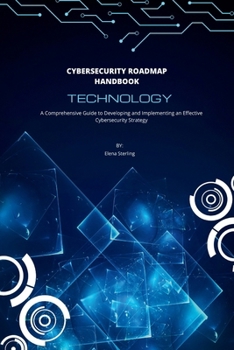Cybersecurity Roadmap Handbook: A Comprehensive Guide to Developing and Implementing an Effective Cybersecurity Strategy (Tech books)
The "Cybersecurity Roadmap Handbook" serves as a comprehensive guide for organizations seeking to fortify their digital defenses and navigate the complex landscape of cybersecurity. Spanning ten key sections, the handbook covers crucial aspects of cybersecurity strategy, from risk assessment and security policies to incident response, legal compliance, and future trends.
Key Themes:
Foundation Building: The handbook emphasizes the importance of a strong foundation, starting with risk assessment and the identification of critical assets. This forms the basis for developing targeted and effective cybersecurity measures.Policy Development: Security policies play a central role in setting expectations and creating a secure environment. The handbook guides organizations in formulating policies for user access, data handling, and incident response, fostering a proactive cybersecurity culture.Technology Infrastructure: Exploring network security, endpoint security, and cloud security, the handbook provides insights into leveraging technology for robust cybersecurity. It covers firewalls, encryption, and device management, aligning technological measures with the evolving threat landscape.Human Element: Recognizing the human factor in cybersecurity, the handbook dedicates a section to security awareness training. It addresses the importance of educating employees on cyber threats, phishing, and social engineering, making them active contributors to a secure environment.Incident Response and Recovery: Acknowledging that incidents are inevitable, the handbook details the creation of incident response plans. It covers incident types, steps for incident handling, and post-incident analysis, ensuring organizations are equipped to respond swiftly and learn from each incident.Legal and Compliance Considerations: Compliance with data protection laws, adherence to industry standards, and the role of cybersecurity insurance are explored. This section emphasizes the ethical and legal responsibilities organizations have in safeguarding sensitive information.Continuous Monitoring and Improvement: Security audits, metrics, feedback loops, and technology upgrades form the core of continuous improvement. The handbook guides organizations in measuring and enhancing their cybersecurity posture over time.Collaboration and Information Sharing: Recognizing the collective strength in unity, the handbook emphasizes industry collaboration, threat intelligence sharing, and public-private partnerships. It underscores the importance of a collaborative approach to tackle the dynamic nature of cyber threats.Future Trends: As a forward-looking guide, the handbook explores emerging trends such as the role of AI and machine learning, challenges posed by quantum computing, and security considerations for IoT devices. It encourages organizations to prepare for the future of cybersecurity.Conclusion and Recommendations: The handbook concludes with a recapitulation of key insights, takeaways, and actionable recommendations. It encourages the establishment of a cybersecurity culture, regular training, continuous monitoring, engagement in collaborative initiatives, and strategic investment in emerging technologies.In essence, the "Cybersecurity Roadmap Handbook" is a holistic resource that empowers organizations to develop, implement, and adapt their cybersecurity strategies. By combining technical measures, human awareness, legal compliance, and collaboration, organizations can build a resilient defense against evolving cyber threats and contribute to the collective security of the digital ecosystem.





